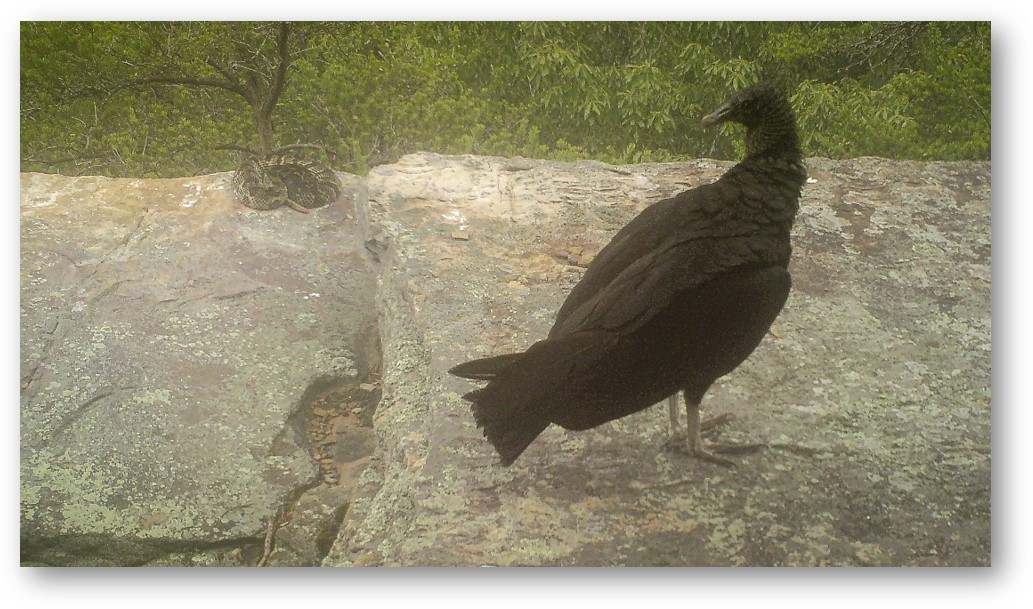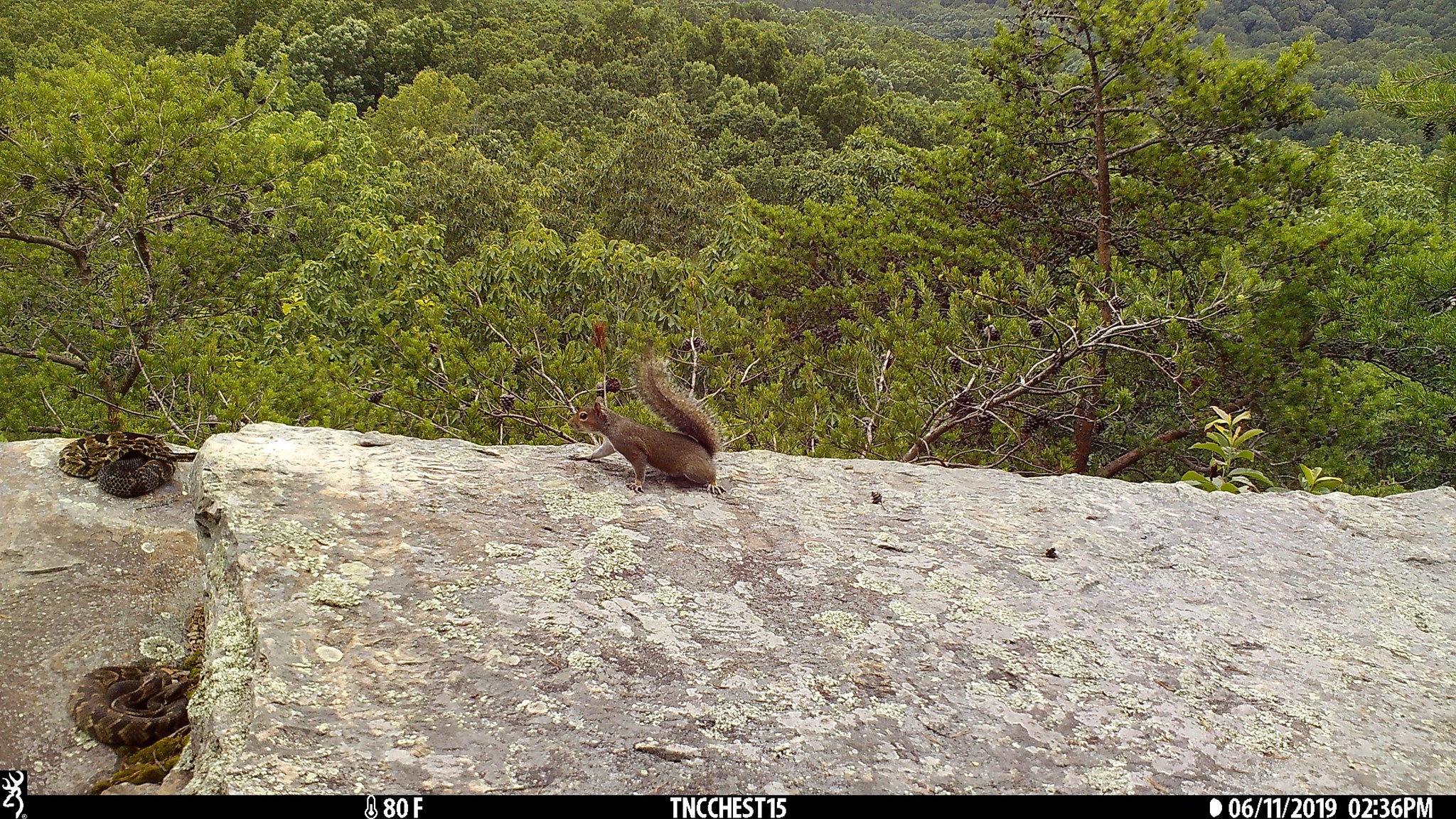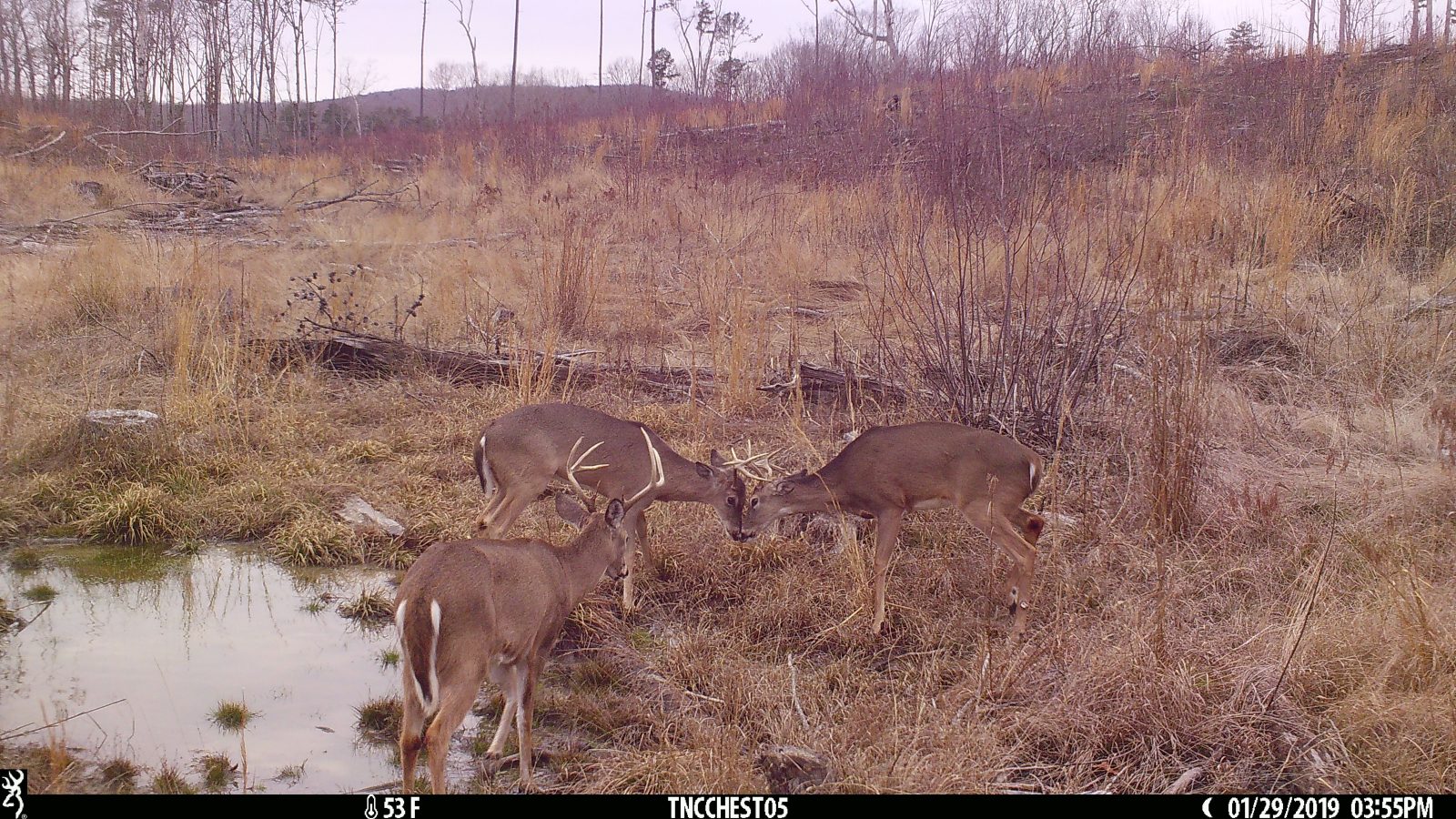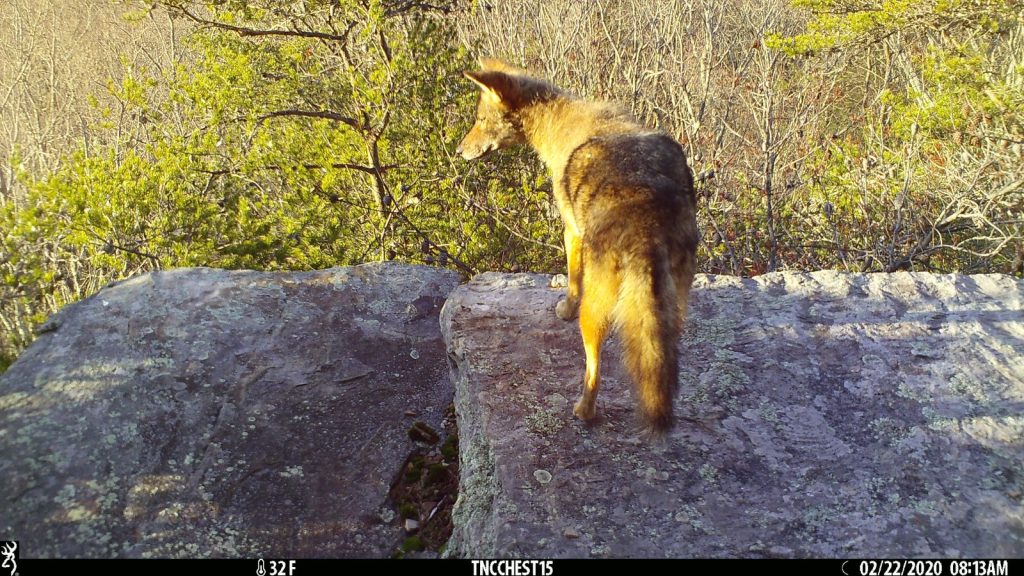After a day viewing conservation projects and forest restoration activities, forester Britt Townsend has saved the best for last. She leads a group to a rocky knoll that provides a big-picture view of conservation.
We’re at Bridgestone Preserve at Chestnut Mountain, a 5,763-acre Nature Conservancy project in central Tennessee. The view from the large rock includes 60,000 additional acres of protected public lands and the Caney Fork River.
And when humans aren’t around, that big rock perhaps becomes even more interesting–as you’ll see with the camera trap images captured here.
History of Bridgestone
Bridgestone has an interesting history. In the 1970s, it was purchased by the Firestone Tire and Rubber Company to use a corporate retreat. When Bridgestone acquired Firestone in 1988, the property remained undeveloped.
Become a Member
Making a lasting impact for nature when you join The Nature Conservancy.
In 2014, Bridgestone began partnering with TNC on forest management, leading to a donation of the property in 2018. Bridgestone Preserve is now a site of research and on-the-ground restoration, a living laboratory that can also help inform conservation activities throughout the southern Appalachians.
A biological inventory was always a priority, and former TNC state director Terry Cook set up camera traps throughout the preserve. The photos and video captured show some of the charismatic creatures that roam the preserve–and some surprises.
Rattlesnakes on the Ridges
Britt Townsend says that, when the preserve was acquired, there were often stories of rattlesnakes on the ridges. She says they suspected there was a hibernaluca–where timber rattlensakes congregate for the winter–nearby.
“We didn’t confirm until we started putting cameras out and we didn’t know about the hibernacula until we started tracking snakes,” she says.
Camera trap images capture the snakes basking and moving about the rocks.

A timber rattlesnake and a vulture share the rock, with a potentially dangerous situation for both. Rattlesnakes are relatively undisturbed at Bridgestone. While researchers still work to understand the place, public visitation is not permitted. Occasional groups go to the overlook, but only when the snakes aren’t using the area.
“People are drawn to large rocks and viewpoints, of course, and heavy traffic would disturb the snakes,” says Townsend.

This dramatic capture leaves one with so many questions: Does the squirrel know the danger it’s facing? Why is it on the rock in the first place? What happens next?
The camera trap doesn’t capture the rest of the sequence so we can only be left wondering. Timber rattlesnakes stay so still and are so well camouflaged. If you’ve hiked much in the Appalachians, you’ve probably walked right by one.
Howling Coyotes
I’ve seen a lot of camera trap footage of coyotes but this is my favorite. I’ve never seen such up-close howling action. Did you know that most “packs” of coyotes you hear howling are actually only one or two animals? Studies have shown that people consistently overestimate the number of coyotes they’re hearing.
As you can see in this video, two coyotes can create quite a racket. While far from uncommon, coyotes are quite difficult to see in the eastern forest.
Long-tailed Weasel
Long-tailed weasels are also not uncommon (although they may be declining), but it’s difficult to catch a glimpse of this elusive predator. When a weasel is on the hunt, it’s in constant motion. As the Princeton Field Guides Carnivores of the World notes, the long-tailed weasel is “ceaselessly investigating burrows, crevices, nests and log hollows for quarry.”
An adult weasel makes 3-4 kills a day, often rodents or small birds.
Camera-Curious Black Bear
Black bears always seem to be doing something interesting on camera, whether it’s napping or shaking off a disturbingly long tapeworm. Or, in this case, messing with the camera trap.
Black bears are curious animals and if they see a flash from a camera trap, they often investigate. And get close. Really close. Townsend says bear sightings at Bridgestone have been increasing every year since TNC acquired the property in 2018. Most of the bears caught on preserve camera traps have been young males passing through or looking for territory.
Eastern Spotted Skunk
Here’s a mammal that’s little-known and even less seen. There are three very similar species of spotted skunk that live over a wide range of the United States and Mexico. They are quite small–about a quarter of the size of a striped skunk–and prefer denser vegetation. Like the striped skunk, they do spray, although the scent is not as pungent.
Western spotted skunks are sometimes spotted by lucky wildlife watchers on the Channel Islands (and often captured on camera trap images). The eastern spotted skunk is arguably even more difficult to spot. It’s considered threatened and little is known about what has caused its decline.
Whitetails in the Forest
Of course, you couldn’t have an Appalachian trail-cam roundup without white-tailed deer. The most abundant large mammal in North America is also one of the most popular. Deer are common at Bridgestone, including some impressive bucks, as this video shows.

Camera traps can capture interesting wildlife behavior. Here three bucks have a standoff, including two of them locking antlers. Given that these are not old deer, this is probably more sparring than actual fighting.
In the summer and early fall, white-tailed bucks often roam in bachelor groups. As the rut approaches in later fall, the animals begin establishing dominance, but the fighting is brief and usually without injury. More serious fights, often among mature bucks, occurs during the rut.
Cue the Wild Pigs
Here’s a species land managers don’t want to see on camera traps: feral pigs. This invasive species, originating from escaped barnyard swine and spread by irresponsible hunters, is now abundant throughout the southeastern United States.
They’re prolific, capable of having multiple litters of piglets a year. They tear up habitat, as we saw firsthand at Bridgestone. And they will eat, well, just about anything.
Confirming the Presence of Golden Eagles

Bridgestone is important for migratory and resident birds, including golden eagles. Golden eagles migrate from Canada to spend the winter in the southern Appalachians. There had been numerous likely sightings of golden eagles at Bridgestone, but their presence had never been confirmed.
Townsend, a forester, decided to try her own luck at camera trapping (all the other photos and videos on this blog were taken by former TNC-Tennessee state director Terry Cook). She set up cameras over a dead feral hog to see what scavengers were about. Her first set captured images of this golden eagle, confirmation of this species on the preserve and what she calls beginner’s luck.
Red-Tailed Hawk
Other raptors are common at the preserve. The red-tailed hawk is familiar in many parts of the United States. It’s adaptable and may be one of the few birds species that has actually increased in population since the 1960s.
Cooper’s Hawk in a Mountain Stream
Little pools of water are wildlife magnets, providing habitat for frogs and salamanders, a place for small predators to hunt and a place for birds to bathe. Here a Cooper’s hawk stops by for a quick rinse.
These raptors are quite adaptable hunters. They will often hide on a perch, typically in dense forest, and ambush unsuspecting birds or small mammals. But they will also fly close to the ground and surprise their prey. They will even chase small mammals on the ground.
In the early 20th century, these hawks were blamed for predation on chickens and gamebirds and thus labeled “bad hawks.” They were shot relentlessly on Appalachian ridges like the one used by the rattlesnakes. Luckily, all North American raptors are now protected and Cooper’s hawks have made a dramatic recovery.
Here Come the Raccoons
We conclude with a species that’s abundant and adaptable, but nonetheless always entertaining to watch. The raccoon has a place in Appalachian culture and lore, but usually we’re only offered a passing glimpse of these curious animals.
Camera traps help researchers inventory wildlife and understand effects of conservation projects. They also provide a fun glimpse into what’s happening in the forest when we’re not looking.




Thanks for the wonderful footage. Gotta love those trail cameras.
Great job. Thanks for posting.
Tom
thank you for sharing these stories and the amazing trail cam. I would love to share these videos (esp. the coyotes- we hear them often) and find it easier in a YouTube or some such format….thank you for making CSG– I love it and frequently share it with others….Best — Diana